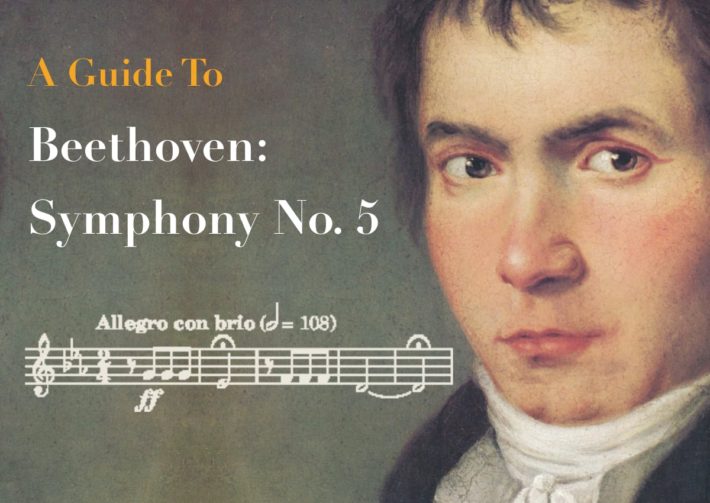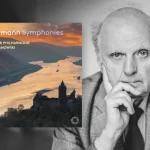The four notes heard at the beginning of Beethoven’s Fifth Symphony are so familiar that everyone, even non-classical music listeners, knows the work. Such familiarity makes us forget just how radically challenging this music sounded when it was first performed on 22 December 1808 in the Theater an der Wien in Vienna, part of what turned out to be a concert lasting over four hours, in a poorly heated concert hall. It was revolutionary then and remains so now.
Beethoven – Symphony No. 5 – Analysis
Listeners in Beethoven’s time came to a symphony performance with certain expectations about its melodic writing and overall structure. The first movement was usually in Sonata Form, consisting of three sections, Exposition, Development and Recapitulation. The form’s symmetry and balance were particularly pleasing to listeners of the time. The Exposition usually presents two themes: the first, featuring vigorous and extroverted writing, is played in the home key. The music then shifts into a new key for the second theme, which contrasts with the initial theme by being lyrical and introverted. The Exposition then repeats to ensure the listener gains familiarity with both themes, thereby ensuring they will more fully appreciate how one or both of those themes is developed in the next section. The Development often features a fragment of one or both themes, modulating that material through a variety of tonal centers. This harmonic journey ends at the Recapitulation, the music sounding exactly as it did in the beginning, except that the music remains in the home key for the second theme, finally closing out with a short Coda that reaffirms arrival at the home key. Classical Period audiences took great pleasure in knowing this structure and judging the music on how it showed ingenuity and originality within these clearly defined rules. But Beethoven was not one to follow rules.
Beethoven’s writing puts tremendous emphasis on rhythm: the Short-Short-Short-Long motif heard in the first four measures is the acorn from which the entire symphony grows. Indeed, the first movement, in dark C-minor, is completely obsessed with this rhythm. Both themes (The first at about 10 seconds in, the second arriving around 45 seconds later) are built from this rhythm, as is the entire orchestral accompaniment. Moreover, although the second subject is in a new key and bit calmer, both themes seem intent on expressing relentless, angry agitation.
At first, Beethoven follows the expected structural norms until we reach the Recapitulation. We hear the beginning music (as expected) and suddenly everyone stops as a solo oboe plays a beautiful little cadenza (4’35”, in Carlos Kleiber’s famous recording). For the briefest of moments, all the anger and anxiety dissipate. But the orchestra resumes its recapitulation, as if the oboe line never even happened.
After the second theme is heard in the home key, the listener expects a short Coda – but Beethoven instead introduces another development (05’52”), completing disrupting the movement’s symmetrical structure and expected harmonic plan. By denying his listeners their anticipated structural signposts, he forced them to listen, first and foremost, emotionally. The second development ends with what initially sounds like another Recapitulation (6’55”), but it is quickly interrupted by the Coda expected a few minutes earlier. In 7 short minutes, we experience and share in Beethoven’s struggles, anger and grief.
A symphony’s second movement was normally slow and lyrical, but in his fifth symphony Beethoven merely honors the lyrical part. Marked “Andante con moto”, we finally hear one of Beethoven’s most beautiful melodies, played by violas and cellos. The theme then quickly shifts into a new key, climaxing with a brass fanfare (Tr. 2, 01’19”), built on the same S-S-S-L rhythmic figure heard in the first movement. But the victory is short-lived – the fanfare quickly loses momentum and fades away. Beethoven now begins to vary the theme with ever-increasing textural complexity. The fanfare motive appears another two times, each time dying away, alerting us that there is more dark and angry emotion to come.
Beethoven Album Reviews
- Review: Beethoven – Complete Symphonies – Vienna Philharmonic Orchestra – Nelsons
- Review: Beethoven – Complete Piano Sonatas – Igor Levit
- Review: Beethoven And Sibelius Violin Concertos – Christian Tetzlaff
Those emotions return with the third movement. Traditionally, a light Minuet and Trio (with an A-B-A symmetrical structure), Beethoven, writes a doom-laden Scherzo. The horns announce the theme (track 3, 0’21”), once again in C minor and built from the S-S-S-L motif. The Trio, which was usually of a contrasting and lighter nature, is even more stern, featuring a short contrapuntal segment beginning in the low strings that works its way through the entire orchestra (1’55”). The return of the “A” material brings another shock – rather than a literal recapitulation, the winds and strings now articulate the music with short, soft notes played pizzicato, once again disrupting any sense of symmetry and balance (3’19”). More radical still is the ending: instead of a Coda, Beethoven creates a harmonically ambiguous passage of 50-measures that connects the third and four movements.
The final movement begins with a powerful C major chord, made overwhelming by new instruments added to the mix. For the first 25 minutes of this work, three trombones, a contrabassoon and piccolo have sat waiting. Adding the instruments at this moment creates a timbre rarely (if ever) heard before, and signals that Beethoven’s long sought-for victory over the anger and struggle of the first three movements has finally arrived. Once again, the S-S-S-L motif is an integral part of the orchestral fabric. Even more fascinating is how the motif changes and reverses the rhythm to S-L-L-L, perhaps suggesting that moving from the darkness into the light is simply a matter of shifting perspective – as if Beethoven is teaching us how he overcame the struggles of his life.
At 5’20” the music of the third movement suddenly reappears, as if to suggest that all the joy experienced in the first five minutes was illusory But when the Recapitulation arrives, it now has added emotional power because it confirms that this joy, this light is the new reality!
There is nothing left to do but celebrate this hard-won victory, and Beethoven does so with an exceptionally long Coda, delaying and misleading the listener with several false endings, until the final passage, at an even faster speed, leads us into the breathless and joy-filled final bars.
Beethoven Symphony No. 5 – The Best Recordings
There are few hundreds of available recordings of Beethoven’s Fifth Symphony, so how does one choose? The list below features performances from various decades, and a mixture of modern and original instrument performances. Each performance successfully captures the radical and revolutionary nature of endlessly fascinating work.
Beethoven: Symphonies Nos. 5 & 7 – Vienna Philharmonic Orchestra, Carlos Kleiber
Kleiber galvanized this orchestra to offer impassioned performances of standard repertoire, and this performance is one of their best collaborations. DG’s most recent transfer of the 1970s recording captures the full glory of Vienna’s opulent sound.
Beethoven: Complete Symphonies, Violin Concerto & Prometheus – Orchestra of the 18th Century, Gulbenkian Choir & Soloists, Frans Brüggen
The 1980s brought a plethora of Beethoven cycles performed on original instruments. Brüggen was one of the best, in part because he allowed himself a greater interpretative freedom and flexibility compared to Hogwood, Goodman and Norrington. One can quibble with his old-fashioned reading of the first four bars, but this is an intensely musical and spiritual performance, with a unity of vision shared between orchestra and conductor that is consistently thrilling.
Beethoven: 9 Symphonies – Berliner Philharmoniker – Herbert von Karajan
Karajan recorded four complete Beethoven cycles, three of them with his Berlin orchestra. The 1960s cycle features exceptionally rich sound and a palpable fire in the performances. Karajan and the orchestra are at the peak of their interpretative powers, without the heaviness and overly lush sound that are hallmarks of the two later cycles.
Beethoven: Symphonies Nos. 5 & 7 – Pittsburgh Symphony Orchestra, Manfred Honeck
Manfred Honeck’s series of recordings from Pittsburgh have breathed new life into standard repertoire, and the Pittsburgher’s have never sounded better. While some passages show historically informed awareness, others sound old-fashioned – nevertheless, the interpretation is entirely convincing and makes for enthralling listening.
Beethoven – Complete Symphonies – Chamber Orchestra of Europe, Nikolaus Harnoncourt
Still fresh and vibrant as when it was first released in the early 1990s, Harnoncourt may have his quirks, but his approach to the Symphony as a revolutionary piece is never in doubt, and he brings illuminating details based on his experience in working with period instrument groups.

Albums included with an Apple Music subscription:
Support Us
We hope this guide has helped you navigate the wonderful world of classical music! If you enjoyed this free resource, consider making a donation to The Classic Review. Your generosity helps us keep the music playing by allowing us to publish informative guides, and insightful reviews. Every contribution, big or small, allows us to continue sharing our passion for classical music with readers like you.
Donate Here
Latest Classical Music Posts
- Review: “Mozart, You Drive Me Crazy!” – Golda Schultz, Soprano
- Review: Schumann – Complete Symphonies – Dresdner Philharmonie, Janowski
- Review: Mozart – The Sonata Project, Salzburg – Yundi, Piano
- Review: Beethoven – Symphony No. 3 (“Eroica”) – Budapest Festival Orchestra – Iván Fischer
- Conductor Edo de Waart Announces Retirement
- Review: Pergolesi – Stabat Mater, Vivaldi: Nisi Dominus – Patchornik, Engeltjes, PRJCT Amsterdam
Read more classical music reviews or visit The Classic Review Amazon store
Follow Us and Comment:
Get our periodic classical music newsletter with our recent reviews, news and beginners guides.
We respect your privacy.
















